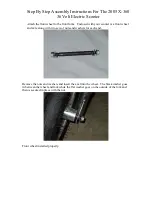
17
EN
GLISH
Elite
2
Mini XS Plus Rev.B
5.0 Using the scooter
DANGER!
• Be aware that you may need to adjust the controller settings
of your scooter.
DANGERS!
Weight limits
• The user, plus options and accessories, plus items carried
should never exceed the maximum user weight.
• Never sit in the scooter while weight training if the total
weight (user plus additional weighs) exceed the maximum
user weight.
• Exceeding the weight limit is likely to damage the seat frame
or fasteners and may cause severe injury to you or others
from scooter failure.
• Exceeding the weight limit will void the warranty
• Do not hang shopping bags from the handlebars as they
could swing and cause loss of steering control or cause
inadvertent drive actions.
• Do not overload the front and rear baskets as steering
control and stability will be negatively affected.
5.1 Checking scooter before use
Perform the following daily check routine before driving:
WARNING!
• Ensure all controls are functioning properly.
• If you discover any scooter malfunction, take it to be
repaired or reset. Your dealer can help you find the fault and
correct it.
• Use extreme care when you drive the scooter in reverse. If
one of the wheels hits an obstacle, you could lose control of
the scooter and fall off.
• When traveling along, always ensure the backrest is upright
and the seat faces forward.
• Never short-circuit electrical connection as you could cause
an explosion.
• Do not use the scooter if any of the tires are damaged or
under/over inflated.
• When using mobile phones you should switch the scooter
off.
• Do no smoke whilst on board the scooter.
• If you take a break from driving, but remain seated on the
scooter for more than just a moment; switch the scooter off
at the ignition key.
CAUTION!
Checking wheels & tyres
• Are the tyres sufficiently inflated (Chapter 8.2).
Checking batteries
• Before using your vehicle for the very first time, please
charge your batteries for a period of 24 hours.
• Are the batteries sufficiently charged? The green lights on
the battery indicator must be on. (Chapter 7.2).
• Do not use the scooter when the battery charge level is low.
The scooter may come to a sudden, unexpected stop.
Checking lights and indicators
• Ensure that the lights and indicators are functioning
correctly and lens are clean before going outdoors at night.
Checking remote
• With the control system switched off, check that the wigwag
is not bent or damaged and that it returns to the centre
when you push and release it.
Checking free wheel lever
• Before using the scooter, ensure that the free wheel lever
has been set to ‘drive’ (Chapter 5.8).
Checking seating
• Ensure that all the cushions are in place.
• Make sure that the backrest is correctly fitted and adjusted.
• Visually inspect the Scooter to make sure the armrests etc.
are correctly positioned and all fasteners are sufficiently
tightened.
Checking clothing on potential entrapment
• When operating the scooter, ensure that your clothing
does not hamper the Scooter (i.e. too long). Before use,
always check if your clothing or accessories do not come
into contact with the wheels or and other moving and/or
rotating parts in which they could become entangled.
Checking weather conditions
• In winter, batteries have a reduced capacity. During a period
of light frost, the capacity is roughly 75% of the normal
capacity. At temperatures below -5˚C this will be roughly
50%. This will reduce your range of action.
WARNING!
Avoid wearing loose cuffs/sleeves when operating the wigwag/
side-throttle as this could cause entanglement.
















































